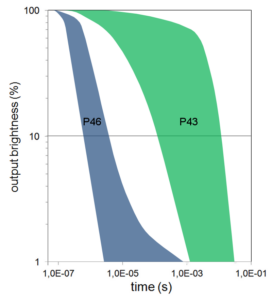< Back
Intensifier Control
Phosphors
Phosphor Decay Time
The anode screen of the image intensifier contains a layer of phosphorescent material. Upon impact of an electron, the phosphor screen will emit light. Depending on the type of phosphor, the intensity of the emitted light will decrease faster. The more efficient the phosphor, the slower its light intensity decays after excitation.
Our time-resolved cameras and camera attachments use P43 phosphor. The high luminous efficiency of this phosphor increases the light levels at the output of the image intensifier. This increases the quality of the resulting image.
Our high-speed cameras and camera attachments use P46 phosphor. This phosphor has a short decay time, so the light signal of consecutive frames doesn’t get mixed up.
P47 phosphor is available on request, when even faster decay times are required.

Phosphor
P43
P46
P47
Emission
545 nm
530 nm
400 nm
Efficiency (E/KV)
20
6
4
Decay to 10%
1.5 ms
500 ns
100 ns
Decay to 1%
3 ms
2000 ns
400 ns
Photocathodes
The photocathode is the entrance of the image intensifier. This is where the incoming photons are converted to electrons. The quantum efficiency of the photocathode material specifies how efficient this conversion is for each wavelength.
Second generation image intensifiers
The photocathode of a second generation image intensifier can have a quantum efficiency of up to 25%.
S25 photocathodes are only available in the 18 mm diameter image intensifiers.
Typical QE

Typical quantum efficiency (%) of second generation image intensifiers as a function of wavelength (nm).
Second generation high QE image intensifiers
The photocathode of a second generation high QE image intensifier can have a quantum efficiency of over 30%.
Please note that these image intensifiers are only available with a diameter of 18 mm.
Typical QE, 200 ns gate width

Typical quantum efficiency (%) of second generation high QE image intensifiers as a function of wavelength (nm).
Second generation fast-gated high QE image intensifiers
The photocathode of a second generation high QE image intensifier can have a quantum efficiency of over 25%.
Please note that these image intensifiers are only available with a diameter of 18 mm.
Typical QE, 3 ns gate width

Typical quantum efficiency (%) of second generation high QE image intensifiers as a function of wavelength (nm).
Third generation image intensifiers
The photocathode of a third generation image intensifier can have a quantum efficiency of up to 50%.
Typical QE

Typical quantum efficiency (%) of third generation image intensifiers as a function of wavelength (nm).
Image Intensifiers
An image intensifier boosts the intensity of the incoming light. By converting photons to electrons and back to photons, the light intensity can be increased significantly.
Another feature of an image intensifier is that it can act as an ultra-fast shutter. The photocathode can be switched between on and off in a matter of nanoseconds.



